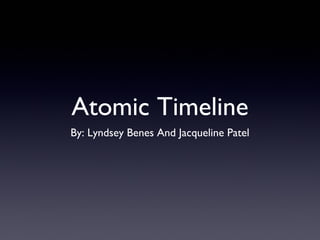
Atomic Timeline: Key Contributors to Atomic Theory
- 1. Atomic Timeline By: Lyndsey Benes And Jacqueline Patel
- 2. Democritus • Lived from 460-370BC • Came up with the word atomos.- lter became called the atom. • Theory was mainly about atoms being in the atmosphere • There are certain atoms for solids and certain atoms for liquids • Atoms are individually created and cannot be separated. • Sizes can differ according to the influences on them. • Atoms cannot be split no matter their size • It is thought of the atom was based off of the analogies from the human senses. • All things are made of atoms, the atoms could not prove them with scientific experiment.
- 3. Aristotle • 384-322BC • Believed that if you keep cutting up pieces of a matter it is always going to be made up of that same thing. • Didn’t believe that atoms could be different sizes. • Believed that the heavens were made up of a fifth element called a aither • His theory had two forces, conflict and harmony • That was his most popular theory.
- 4. John Dalton • Atom was a ball • A gas consists of individual particles • Each element has its own atom • Introduced compounds • Measured the mass of elements that combined when compounds formed • His discovery lead to the atomic theory in 1803 • Discovered colorblindness, and suffered from it. • Studied metrology.
- 5. J.J. Thompson • Discovered isotopes • Discovered that atoms were made up of smaller particles. • Won the nobel prize in physics • Discovered ray tubes and cathode tubes • Estimated the mass of the ray by measuring the heat generated by the ray when they hit the junction and comparing it with the reflection of the rays. • Concluded that the rays were made of negatively charged particles(electrons)- he called them corpuscles- later electrons was suggested be Goerge Stoney. • Concluded that atoms were divisible and made of particles. • Plum Pudding model
- 6. Ernest Rutherford • Completed the gold foil experiment, which he thought would be proof that J.J Thompson’s plum pudding model was correct, but it proved that his model was wrong. • Discovered that the thing in the middle of an atom was called the nucleus. • Discovered the neutron • Discovered the atomic bomb • After his experiment people started to realize that atoms were made up of sub-atomic particles. • Discovered all of the atoms nuclear charge is in the nucleus.
- 7. James Chadwick • Discovered the neutron with Rutherford. • Discovered that the unknown particles were in the nucleus • This has been know as the neutron because is had no charge • his discovery of the neutron became essential to the understanding of the nuclear fussium of uranium 233. • Nobel Prize in Physics • Got the Franklin Medal • Got the Hughes Medal
- 8. Erwin Schrueinberg • Physicist • Found more proof of the quantum theory • Electrons are on energy levels • Discovered the wave configuration • Started working in Berlin, Germany but had to escape because of Hitler. • Worked with Max Planck. • Figured out that an orbital can only hold 2 electrons • Discovered the four main types of orbitals; S, P, D, F orbitals
- 9. Neils Bohr Neils Bohr • Believed that electrons existed on specific energy levels. • Electrons moved in orbits around the nucleous • Fixed distances apart • Light is emmited when the electron becomes excited then comes back in waves.
- 10. Louis De Broglie • Proposed moving particles. • Won the nobel prize in physics • Thought that the electrons have dependencies similar to photons and that electrons move in waves. • Used Max Planck studies. • Determined that both forms of energy existed in particles and wave lengths.
- 11. Werner Heisenberg • Won the nobel prize in Physics. • Created theory on Quantum Mechanics. • In 1927 he published his “Uncertainty Principle” • Made contributions to many different science branches. • Helped plan the first West Germany Nuclear Reactor in Karlsruhe. • President of the Germany Research Council. (GRC)